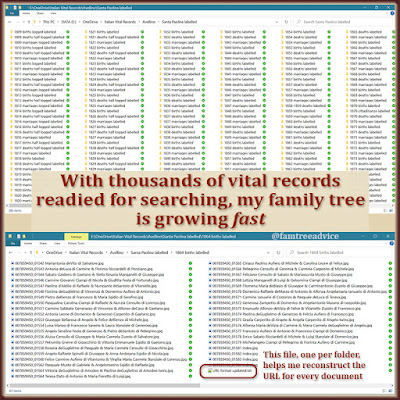This will anger some genealogists, but here goes. I added 500 people to my family tree in a couple of days. It was fun and easy. Here's how it works.
Examining the Documents
I made the entire collection of an Italian town's vital records searchable on my computer. I had already downloaded the town's documents to my computer. I put them in 386 folders—one for each year's birth records, marriage records, and death records, from 1809 to 1945.
Then I viewed every single document image to see who it belonged to. Each file comes with a name like 007859450_00687.jpg. This number helps me recreate the exact URL where anyone can find it for themselves. I use that URL in the source citation. (The naming system changed in more recent times.) So I kept the numbers, but I added the name of the person(s) in the document.
 |
| Why settle for only my 2nd great grandparents' 1871 marriage record when TONS of cousins are waiting for me in this collection? |
A lot of people in the town have the same name. So it's extremely helpful to include the name of the person's father in the file name. In Italian, di means of, and it's how they state the name of a person's father. "Vitantonio Egidio di Pasquale" means that Pasquale is the father of Vitantonio Egidio. It's also a handy shorthand for my file names:
- 007859450_00688 Angelarosa Lombardo di Felice and Pasquale Musto di Carmine.jpg
- 007859450_00689 Maria Spinelli di Francesco and Saverio Spinelli di Vincenzo.jpg
- 007859450_00690 Angelo Raffaele Carpenito di Saverio and Paolina deGuglielmo di Antonio.jpg
Finding What's Missing
With all the files renamed, I can search for anyone. I use a free Windows program called Everything. Let's say I want to find all the children born to a particular man. I simply type his last name "di" his first name in quotes—"deGuglielmo di Antonio"—into Everything.
 |
| The cousins pile up fast when all their names are at your fingertips. |
Santa Paolina, Avellino, Italy, is the hometown of my 2nd great grandmother and her paternal ancestors. Its population may have peaked at 2,487 in 1951. I want to identify as many Santa Paolina cousins as possible. This can help me connect to distant cousins around the world.
I've already found all my direct Santa Paolina ancestors. Now I'm going sideways. One generation at a time, I'm finding all the siblings of my direct ancestors. Who did they marry? Who were their spouses' ancestors? Who were their children, and who did their children marry? All the answers are in my renamed files.
Just the Facts
The only way I could add 500 cousins so quickly is by taking off the training wheels for a while. Normally I add vital records images to my family tree as I find them, along with a source citation. Right now, for this town, I'm adding only the names and facts and moving on.
There's no risk for me in skipping these important documents and sources. They're only a couple of clicks away. The vital records are easily searchable on my computer. I can find them again whenever I want. If a distant cousin finds my tree on Ancestry.com, I'll add the documents and sources for our mutual benefit. (Note that in late 2025, I'm more than a year and a half into creating these missing citations. Never skip the citations!)
I would not, and do not, do things this way with census records, ship manifests, or any record I find on Ancestry.com. I gather the document and create a source citation immediately. But the Italian vital records on my computer (and backed up in triplicate) are very easy to put my hands on again.
But right now, I'm owning my Santa Paolina heritage 100%. My grand aunt used to say the family was from Avellino. But she didn't know which town, or which ancestors. I'm so happy I discovered the answers. I'm running with it!
It's amazing to see how this process is working. I choose, let's say, a 3rd great uncle. I find out who he married and add her birth date and her parents' names. Then I find her parents' marriage so I can learn their parents' names. And I can look for their death records and learn their parents' names.
Coming back to that 3rd great uncle, I search for all the children he and his wife had. I search for his death, and his wife's. I search for the marriages and deaths of his children. I follow the children's children as far as the records will take me.
You can see how easy it would be to quickly add 500 people this way.
From what I've seen, the best way to connect to many DNA matches is to have their grandparents in your family tree. I will keep going, harvesting facts from Santa Paolina, and my other ancestral towns. And if anyone finds a hook into my tree? Well, they're going to be in for quite a shock.
When I find Italian records on Antenati or FamilySearch they are yellowed and low contrast. How do you modify them to be read?
ReplyDeleteAll the documents I've seen are grayscale, but if I'm going to put one in my family tree, I always open it in Photoshop to enhance the contrast. I don't think there's anything you can do online.
DeleteHow did you download all of the towns records?
ReplyDeleteThere is a Portuguese-language program called GetLinks written for this purpose. See how to use it at the bottom of my article at http://bit.ly/antenati
Delete